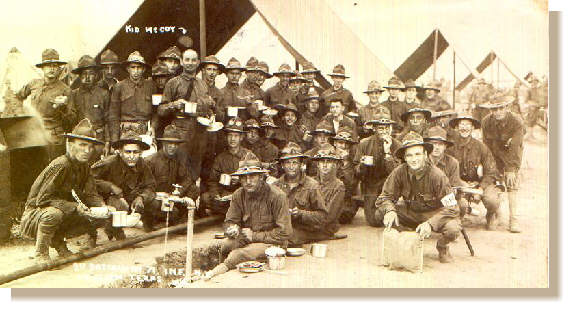The 71st Regiment of the New York National Guard along the Texas–Mexico border in 1916.
The 1898 war marked the last time the United States relied on state-recruited volunteers to man its wartime armies. In 1903, Congress reorganized the Army, created a general staff system, and replaced the 1792 Militia Act with a law granting federal aid to the National Guard and authorizing the War Department to oversee Guard organization. The new law began a 20th-century trend wherein Congress increased aid to the state soldiers while expanding the Army’s authority over them. Between 1901 and the mid- 1930s, annual federal aid grew from $1 million to $32 million. At the same time, the War Department imposed Army inspections, training requirements, and officer examinations. It told the states what units to organize and disbanded local units that failed federal inspections.
Expanding federal control precipitated bitter confrontations between Army officers and National Guard leaders, an on-again, off-again conflict that has endured to the present. (In 1916, 1920, and in the mid-1940s, the War Department attempted to eliminate the Guard as a federal reserve.) Guardsmen wanted federal money and a legal role as the Army’s reserve but resented what they saw as federal intrusion into state military matters. Although federalization altered permanently the state volunteer’s place in American military policy, the National Guard retained a state status in peacetime. The Guard continued to recruit young men to its local units and kept much of its old social-fraternal-athletic character. Strike duty, especially in the years 1900 to 1920, remained the Guard’s major active duty service to the states. As the Army did not expect the Guard to be a combat-ready reserve, weekly drills and summer camps were not very demanding, and in many respects the Guard continued to govern its daily affairs.
Guardsmen confronted the reality of what it meant to accept federal drill pay when ordered to federal service in 1916, 1917, and 1940. Few guardsmen understood that enlistment meant they were obliged to report for duty when called by the president. The 1916 mobilization, which sent the Guard to patrol the Mexican border, first demonstrated the Army’s authority over the Guard. Guardsmen learned during the mobilizations that, when in federal service, the Army could reorganize the Guard as needed, discharge unfit officers, and send state soldiers overseas.
During the world wars, conscription replaced the state volunteer system as the chief source of wartime manpower The National Guard nonetheless made major contributions: Guard units provided 40 percent of the infantry divisions during World War I. The entire Guard mobilized for World War II. Soldiers of Wisconsin and Michigan’s 32nd Division fought early battles in New Guinea, Texans in the 36th Division battled their way up the Italian peninsula, and Virginia’s 29th Division went ashore on Omaha Beach on June 6, 1944. Although the National Guard retained its traditional right to fight, and the federal government spent billions on the state forces after 1945, the Guard’s contribution to the nation’s war armies declined steadily throughout the 20th century as the nation turned to the draft. Consequently, the largest number of guardsmen serving in a national conflict after 1898 did so in World War I (400,000.) Just 300,000 guardsmen (100 percent of the force) were called for World War II and the numbers declined steadily thereafter.
